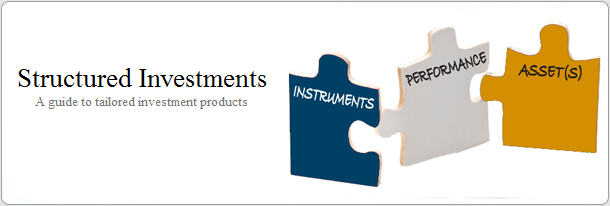Structured Products Guide
Post on: 7 Апрель, 2015 No Comment

Structured Products
Look anywhere for an answer to the question, ‘what are structured products?’, and you will find no single, common response. Investors and their advisors will be met with a range of options — from the individually-designed, to a diverse range of off-the-shelf offerings.
This is the point: they are bespoke investment vehicles, either tailored to meet the aims of a (necessarily, high net worth) individual, or intended for a general retail offering but with a risk/reward profile designed to achieve a specific set of objectives.
These objectives will generally combine an element of capital protection — possibly even a full return of capital guarantee — with a degree of participation in the return from a higher-performing, but riskier, underlying asset.
The variety in the design and the providers of these instruments counters the enquirer’s original question with the fundamental consideration here: ‘what do you want your structured investment to be?’
The London Stock Exchange (LSE) says that the term ‘structured products’ simply refers to a group of financial instruments with varying terms, payout and risk profiles on a range of underlying assets. They fall into broad categories, not all of which are either available or suitable in the retail marketplace.
Ultimately, the product structure will be set out transparently in its literature, and the investor should be able to assess the maximum and minimum returns that could be expected. And if this is not the case, the investor should be very sure about the proposition they’re considering.
This guide aims to explore some of the more common retail forms of this type of investment.
The asset class now known as structured products has been evolving for some time. Its roots lie in the guaranteed bonds marketed by life offices from the 1970s onwards. But a trigger was required if any significant departure from established themes were to be possible.
The first shift came with the establishment of the London International Financial Futures Exchange (LIFFE). This created a market in financial derivatives — options — that for the first time allowed their purchasers to take advantage of equity market movements without being exposed to ownership of the equities themselves.
Confidence in the use of derivatives — and in the quality of the financial institutions backing them — soon grew to the point where providers were constructing new, composite offerings: an early form of structured products.
The first of these to be launched on the retail market were the guaranteed equity bonds that made their debut in 1991. Little was to change in the concept behind these rather basic products until the early 21st century, and their simplicity may account for the lukewarm reception they met among more sophisticated investors.
In 2002-2003 a form of structured investment which came to be known as ‘precipice bonds’ made the news. These offered higher market participation, promising big returns in rising markets, but at a cost of a punishing downside penalty, and little in the way of a safety net if the markets should fall. The markets did slide, and many bondholders found themselves bearing a 2% drop in their investment for every 1% of market fall.
It is no surprise that precipice bonds are rarely to be seen these days.
The Market Today
If the precursors to today’s products were seen as unsophisticated, inflexible or — in the case of precipice bonds — downright ruinous to financial health, things have now moved on considerably.
With the arrival of wrappers like PEPs, TESSAs and ISAs, more tax-efficient vehicles became available to UK investors. Moving underlying investments into offshore domiciles has created further tax savings.
In recent years, the providers of these products have explored ever more innovative combinations of underlying asset mixes which have, in combination with relatively benign market conditions, enabled them to offer a wider range of terms and guarantees.
These instruments have become so popular today that, in May 2005, the London Stock Exchange created a new market segment to accommodate them; the government-backed NSI (National Savings & Investments) has issued £800 million in such products over the past two years; in 2004, the UK market for them attracted around £6 billion of new investment, and hundreds of new issues were launched.
It is fair to say that structured products are moving into the mainstream, as more and more providers develop and market them.














